Continuity mistake: In a sequence in the cockpit of the space ship approaching docking, the shot shows the two pilots and 3 monitor screens between them. The right-hand screen changes from a data display to a blank showing only the letters "GDE" (possibly "GOE"). The next shot is a close-up of the three monitors, and the right-hand one now shows its earlier data display. The other two do not show this behaviour. (00:25:00)
Continuity mistake: During Heywood's meeting with Elena and Dr Smyslov, he is introduced to their colleagues, including Dr Kalinan who is the women in the olive dress/suit. When they shake hands her coat is folded neatly over her seat, but before she sits down again with the camera now facing Heywood, the coat disappears. In an earlier shot prior to the introduction, the majority of Kalinan's coat is off the seat and when she stood the first time it probably fell, suggesting the handshake sequence was re-filmed after the actual meeting. (00:28:45)
Continuity mistake: When Floyd and his team are heading to the Lunar excavation site, they start to eat those synthetic sandwiches. One of the shots shows a closeup of Floyd. As he is right about to take a bite, the camera cuts back to a shot of the three men. However, Floyd's sandwich is instantaneously about a foot from his mouth and he is fully chewing. (00:47:50)
Continuity mistake: Frank is running around the centrifuge. He passes the ladder with two bunks to the right and the work station to the left. When Dave comes down the ladder, the bunk is to the left. This error is caused by Frank's last two running shots (the ones where the camera stayed just ahead or just behind him as he ran) having been accidentally reversed in editting. Frank's hair is parted on the wrong side and the sleep tube layout and the body positions within are precise mirror images of the layout seen in all prior and following shots. (00:56:50 - 00:57:55)
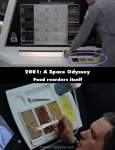
Continuity mistake: When Dave gets his supper, the order of the slop from right to left is yellow, light brown, light brown, dark brown. Later when he's eating, the order is yellow, orange brown, dark brown, light brown. (00:59:00 - 00:59:50)
Continuity mistake: Dave only takes one utensil on his tray, later he has two. (00:59:00)
Continuity mistake: When HAL asks Dave the personal question after inspecting his renderings, the position of the sketch pad changes between shots: right side of body to left side, on his lap, etc. (01:06:15)
Continuity mistake: As Bowman enters B-pod to retrieve the AE-35 Unit, he lifts his left foot into the pod first. But as Poole is watching him do so on a monitor, Bowman lifts his right foot into the pod first. (01:12:45)
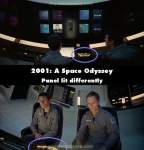
Continuity mistake: When Frank Poole and Dave Bowman are discussing with HAL the possibility of HAL being in error predicting the AE-35 Unit fault, the 10x3 grid of buttons on the console in front of them is lit differently depending on whether the shot is from behind the men, or in front of them. (01:20:40 - 01:23:00)
Continuity mistake: When Bowman attempts to rescue Poole, he enters "C-pod" which, from HAL's vantage point, is the right-most pod. But when we see a close-up of the pod's door closing, we see it is located on the center pod platform, meaning this is B-pod, not C-pod - yet B-pod is the one Poole was using and it is tumbling away in space at this time. We can also see, just barely, that all three pods are present in this same shot. (01:32:45)
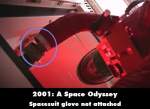
Continuity mistake: After David Bowman returns to Discovery One, HAL disables all life support systems in order to protect "himself" from being shut off. But Bowman successfully enters the ship, grab a helmet and goes to the Logic Center, to shut down HAL by disabling the Memory Banks. But, when opening the hatch to enter the Memory Bank, you can see his naked left wrist, for the spacesuit and the glove are disconnected. (01:51:10)
Continuity mistake: In several scenes, we are given HAL's visual perspective as if seeing through his lens. This is done with an overlayed image of the lens on whatever area is in sight of the lens. As Dave is entering HAL's memory circuit room (red lighting), one shot again suggests we are again seeing what HAL sees, but there is no HAL lens located and oriented to provide the angle we see. A lens would need to be mounted on the narrow wall directly opposite the circular doorway, yet HAL's lens in this room is mounted on the 'ceiling'. (01:51:25)
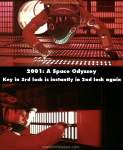
Continuity mistake: When Dave begins to disconnect HAL's circuits, one angle shows him unlock the first, second, then third unit. Just as he's about to remove the key from the third lock, the angle changes and he's pulling the key from the second lock and then goes for the third again. We know this is consecutive time as HAL is pleading with Dave the entire time. (01:51:45)
Continuity mistake: The view of the front of the moon buggy shows the sunlight coming from the right side of the screen(Pilot's left shoulder) But when we see his view out the window, the sunlight casts shadows as if the sun was behind them.
Continuity mistake: Several times during Heywood's speech to the team at the moon base, his arms shift from his sides with hands in pockets to in front of him with hands on the podium.
Continuity mistake: The formation of the astronauts on the ramp to TMA-1 shifts from shot to shot.
Continuity mistake: The Discovery's crew quarters has five beds, three for the hibernating crew, two for the Bowman and Poole. The exact beds occupied by hibernating crew changes from one scene to the next. This error is caused by Frank's last two running shots (the ones where the camera stayed just ahead or just behind him as he ran) having been accidentally reversed in editting. Frank's hair is parted on the wrong side and the sleep tube layout and the body positions within are precise mirror images of the layout seen in all prior and following shots.
Continuity mistake: When Frank receives his parents' birthday message he is relaxing on the sun-bed. As the message drags on there is some intercutting with various other views about the room. One shot happens to be of the sun-bed from an alternative angle, and Frank is nowhere to be seen. In the next shot Frank is once again lying on the bed.
Continuity mistake: On board the Aries Moon Shuttle is the famous scene when the Pan Am flight attendant serves a meal to Dr. Floyd and then retrieves additional meals, enters the doorway and walks 180 degrees up the wall and over to be upside down to deliver the meals to the shuttle pilots. However, from the outside view of the spacecraft, the pilots are sitting perpendicular to where the passengers sit and she should only have walked up the wall 90 degrees.
Continuity mistake: When the astronauts are approaching the monolith on the moon, the earth is clearly seen in a gibbous phase near the horizon. In the next scene, the sun passes behind the earth, which is now in a "new" phase overhead. The earth does not change its position in the lunar sky, and certainly cannot change phase that fast.
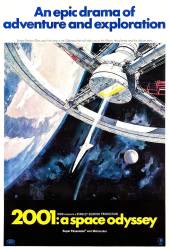





Suggested correction: The shuttle lands "on its back" with legs extending beyond the engines. As in most traditional sci-fi, and ALL actual, space flights to date, the launch (and landing) orientation for humans is to be on one's back. This minimizes blood being sucked down to your feet if you were sitting upright at launch - you could pass out. So we see this when the shuttle lands on the moon - the cockpit (red window) faces up (pilots on their backs, facing out the window). When we presume that the passenger cabin was 180 degrees spun around from the cockpit seating, they're still on their backs. Any loose objects would have been stowed before landing - the airlines don't lock down your bags, newspapers and coffee cups, right? They're loose in the cabin during flight, but put away on takeoff and landing.
Airliners do not fly upside down. The Orion shuttle cannot possibly operate the way it does if it lands in a gravity environment - some rooms are upside down relative to others - why else would the stewardess do the 180 degree vertical walk? It is an idiotic design flaw, and the posting is 100% correct.
The Aries passengers sit and stand with their feet down towards the moon. The pilots sit with their back down to the moon, as conventional astronauts do on Earth. But the attendant's 180-degree walk is completely wrong to the orientation of the shuttle's interior: it should have been only 90° if you look at the Aries exterior. One assumes that Kubrick preferred a longer, more cinematic shot, over a technically accurate shot. But nobody was upside-down to the moon.